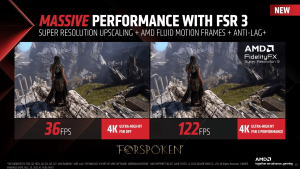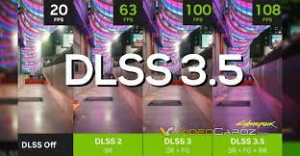1. Introduction: AMD FSR 3 vs. NVIDIA DLSS 3.5
In the realm of gaming graphics, a monumental clash is unfolding as AMD’s FidelityFX Super Resolution 3 (FSR 3) squares off against NVIDIA’s Deep Learning Super Sampling 3.5 (DLSS 3.5). This article delves into the intricacies of these cutting-edge upscaling technologies, shedding light on their features, advantages, and potential implications for gamers worldwide.
2. Unveiling AMD’s FSR 3
As the latest evolution of AMD’s FidelityFX Super Resolution, FSR 3 takes center stage with promises of elevated performance and image fidelity. This section explores the origins and significance of FSR, delving into the enhancements introduced in FSR 3 and how they might shape the gaming landscape.

3. The Open Technology Advantage
One key differentiator of FSR 3 is its open technology approach. Unlike proprietary solutions, FSR 3 welcomes modern GPUs from AMD, Intel, and NVIDIA into its fold. This segment examines the implications of FSR 3’s versatility, including its potential to democratize improved image quality and smoother gameplay across a wide range of hardware.

4. Introducing Fluid Motion Frames
A standout feature of FSR 3 is “Fluid Motion Frames,” a response to NVIDIA DLSS 3.5’s AI-driven enhancements. This innovative technique inserts interpolated frames between rendered frames, promising a significant boost in frame rates. We delve into the mechanics of this feature and its potential impact on gaming experiences.

5. The AI Factor: DLSS 3.5’s Advantage
While FSR 3 boasts algorithm-based enhancements, NVIDIA DLSS 3.5 harnesses the power of artificial intelligence to achieve remarkable upscaling results. This section dissects DLSS 3.5’s reliance on AI-driven Ray Reconstruction, comparing its methodology with FSR 3’s approach and examining the potential trade-offs.

6. Performance and Detail: A Head-to-Head
In the quest for superior performance and image quality, FSR 3 and DLSS 3.5 stand at the forefront. We analyze their real-world impact, considering factors such as frame rate gains and visual fidelity. By juxtaposing these technologies, readers gain a comprehensive understanding of their respective strengths and weaknesses.
7. Choosing the Right Tech for You
A crucial question arises: which technology is the right fit for your gaming setup? This segment provides actionable insights for decision-making. Whether you’re an AMD GPU user or seeking alternatives to DLSS, the article offers guidance on optimizing your gaming experience through informed tech selection.
8. Embracing the Future of Gaming Graphics
Gaming graphics are evolving, and FSR 3 and DLSS 3.5 play pivotal roles in this evolution. This section places the battle between these technologies within the broader context of gaming’s visual future, encouraging readers to embrace innovation and explore the possibilities that lie ahead.
9. Arol Wright: Your Guide Through the Tech Battlefield
Meet Arol Wright, an adept tech enthusiast, and writer who serves as your expert guide through the intricate terrain of upscaling technologies. With a wealth of experience and a knack for simplifying complex concepts, Arol bridges the gap between tech jargon and reader-friendly insights.
10. Conclusion: Elevate Your Gaming Experience
As the dust settles on the showdown between FSR 3 and DLSS 3.5, one truth remains: the pursuit of enhanced gaming visuals and performance is an ongoing journey. This closing section underscores the pivotal role of upscaling technologies, urging readers to make educated choices that align with their gaming aspirations. Whether you’re an AMD loyalist or an NVIDIA aficionado, the path to gaming excellence begins with understanding the intricate dance between FSR 3 and DLSS 3.5.











